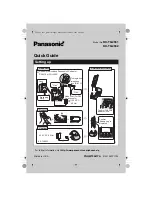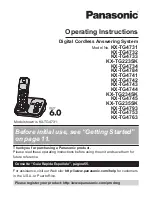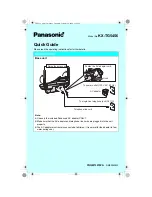
Translation of the Original Instruction Manual
General Safety Instructions
WARNING
To reduce the risk of injury, the user must read and understand
the instruction manual.
WARNING
Read all instructions. Failure to follow all instructions listed below
may result in electric shock, fire and/or serious injury. The term ”power tool“ in all of
the warnings listed below refers to your mains operated (corded) power tool or
battery operated (cordless) power tool, also machines and electric units. Only use
the power tool for the purpose for which it was intended, with the due attention to
the general safety and accident prevention regulations.
KEEP ALL SAFETY NOTES AND INSTRUCTIONS FOR THE FUTURE.
A) Work area
a) Keep work area clean and well lit.
Cluttered and dark areas invite accidents.
b) Do not operate power tools in explosive atmospheres, such as in the pres-
ence of flammable liquids, gases or dust.
Power tools create sparks which
may ignite the dust or fumes.
c) Keep children and bystanders away while operating a power tool.
Distrac-
tions can cause you to lose control.
B) Electrical safety
a) Power tool plugs must match the outlet. Never modify the plug in any way.
Do not use any adapter plugs with earthed (grounded) power tools.
Unmodi-
fied plugs and matching outlets will reduce risk of electric shock. If the power tool
comes with an earthed wire, the plug may only be connected to an earthed
receptacle. At work sites, in damp surroundings, in the open or in the case of
comparable types of use, only operate the power tool off the mains using a 30 mA
fault current protected switch (FI breaker).
b) Avoid body contact with earthed or grounded surfaces such as pipes,
radiators, ranges and refrigerators.
There is an increased risk of electric shock
if your body is earthed or grounded.
c) Do not expose power tools to rain or wet conditions.
Water entering a power
tool will increase the risk of electric shock.
d) Do not abuse the cord. Never use the cord for carrying, pulling or unplug-
ging the power tool. Keep cord away from heat, oil, sharp edges or moving
parts.
Damaged or entangled cords increase the risk of electric shock.
e) When operating a power tool outdoors, use an extension cord suitable for
outdoor use.
Use of a cord suitable for outdoor use reduces the risk of electric
shock.
C) Personal safety
This appliance is not intended for use by persons (including children) with
reduced physical, sensory or mental capabilities, or lack of experience and
knowledge, unless they have been given supervision or instruction
concerning use of the appliance by a person responsible for their safety.
Children should be supervised to ensure that they do not play with the appliance.
a) Stay alert, watch what you are doing and use common sense when operating
a power tool. Do not use a power tool while you are tired or under the influ-
ence of drugs, alcohol or medication.
A moment of inattention while operating
power tools may result in serious personal injury.
b) Use safety equipment. Always wear eye protection.
Safety equipment such
as dust mask, non skid safety shoes, hard hat, or hearing protection used for
appropriate conditions will reduce personal injuries.
c) Avoid accidental starting. Ensure the switch is in the off position before
plugging in.
Carrying power tools with your finger on the switch or plugging in
power tools that have the switch on invites accidents.
d) Remove any adjusting key or wrench before turning the power tool on.
A
wrench or a key left attached to a rotating part of the power tool may result in
personal injury.
e) Do not overreach. Keep proper footing and balance at all times.
This enables
better control of the power tool in unexpected situations.
f) Dress properly. Do not wear loose clothing or jewellery. Keep your hair,
clothing and gloves away from moving parts.
Loose clothes, jewellery or long
hair can be caught in moving parts.
g) If devices are provided for the connection of dust extraction and collection
facilities, ensure these are connected and properly used.
Use of these devices
can reduce dust related hazards.
h) Only allow trained personnel to use the power tool.
Apprentices may only
operate the power tool when they are over 16, when this is necessary for their
training and when they are supervised by a trained operative.
D) Power tool use and care
a) Do not force the power tool. Use the correct power tool for your application.
The correct power tool will do the job better and safer at the rate for which it was
designed.
b) Do not use the power tool if the switch does not turn it on and off.
Any power
tool that cannot be controlled with the switch is dangerous and must be repaired.
c) Disconnect the plug from the power source before making any adjustments,
changing accessories, or storing power tools.
Such preventive safety meas-
ures reduce the risk of starting the power tool accidentally.
d) Store idle power tools out of the reach of children and do not allow persons
unfamiliar with the power tool or these instructions to operate the power
tool.
Power tools are dangerous in the hands of untrained users.
e) Maintain power tools. Check for misalignment or binding of moving parts,
breakage of parts and any other condition that may affect the power tools
operation. If damaged, have the power tool repaired by a qualified expert
or by an authorised REMS after-sales service facility before use.
Many
accidents are caused by poorly maintained power tools.
f) Keep cutting tools sharp and clean.
Properly maintained cutting tools with
sharp cutting edges are less likely to bind and are easier to control.
g) Secure the workpiece.
Use clamps or a vice to hold the workpiece. This is safer
than holding it with your hand, and also it frees both hands to operate the equip-
ment.
h) Use the power tool, accessories and tool bits etc., in accordance with these
instructions and in the manner intended for the particular type of power
tool, taking into account the working conditions and the work to be performed.
Use of the power tool for operations different from those intended could result in
a hazardous situation. All unauthorised modifications to the power tool are
prohibited for safety reasons.
E) Battery tool use and care
a) Ensure the switch is in the off position before inserting battery pack.
Inserting
the battery pack into power tools that have the switch on invites accidents.
b) Recharge only with the charger specified by the manufacturer.
A charger
that is suitable for one type of battery may create a risk of fire when used with
another battery pack.
c) Use battery tools only with specifically designated battery packs.
Use of
any other battery packs may create a risk of injury and fire.
d) When battery pack is not in use, keep it away from other metal objects like
paper clips, coins, keys, nails, screws, or other small metal objects that
can make a connection from one terminal to another.
Shorting the battery
terminals may cause bums or a fire.
e) Under abusive conditions, liquid may be ejected from the battery, avoid
contact. If contact accidentally occurs, flush with water. If liquid contacts
eyes, additionally seek medical help. Liquid ejected from the battery may
cause irritation or bums.
f) Do not use the battery/charger at battery/charger temperatures or ambient
temperatures of ≤ 5°C/40°F or ≥ 40°C/105°F.
g) Do not dispose of defective batteries in the normal domestic waste. Take
them to an authorised REMS after-sales service facility or to a reputed
waste disposal company.
F) Service
a) Have your power tool serviced by a qualified repair person using only
identical replacement parts.
This will ensure that the safety of the power tool
is maintained.
b) Comply with maintenance instructions and instructions on tool replace-
ments.
c) Check mains lead of power tool regularly and have it replaced by a qualified
expert or an authorised REMS after-sales service facility in case of damage.
Check extension cable regularly and replace it when damaged.
WARNING
Specific Safety Instructions
● Use personal safety equipment (e.g. protective glasses, ear protectors, dust
mask).
● Warning! Chips eject sidewards and to the front. Keep other people away.
● Do not overload the saw and the saw blade. Do not use too high feed pressure.
● Use clamps or another practical way to secure and support the work piece to a
stable platform. Holding the work by hand or against your body leaves it unstable
and may lead to loss of control.
● If the replacement of the supply cord is necessary, this has to be done by the
manufacturer or his agent in order to avoid a safety hazard.
● Wear a dust mask for work which creates dust. Observe the regulations for the
prevention of accidents.
● The Ni-Cd and Li-Ion batteries cannot be interchanged in the drive machine.
DANGER
Electric shock!
● Hold power tool by insulated gripping surfaces (”A“), when performing an opera-
tion where the cutting accessory may contact hidden wiring or its own cord.
Cutting accessory contacting a ”live“ wire may make exposed metal parts of the
power tool ”live“ and could give the operator an electric shock.
● Watch that no residual water runs into the motor while sawing lines caryingwater.
1. Technical Data
1.1. Article numbers
REMS Tiger ANC drive unit
560000
REMS Tiger ANC VE drive unit
560008
REMS Tiger ANC SR drive unit
560001
REMS Tiger ANC pneumatic drive unit
560002
REMS Panther ANC VE drive unit
560005
REMS Cat ANC VE drive unit
560004
REMS Akku-Cat ANC VE drive unit Li-Ion
560009
eng
eng
Fig. 1 – 3
1 Clamping screw with locking
handle
2 Guide bracket
3 Mounting pin
4 Blade thrust piece
5 Saw blade
6 Support shoe
7 Switch trigger
8 Overload protection
9 Clamping screw
10 Speed regulating switch
11 Lever
12 Dial
”A“ Insulated gripping surface
Содержание Cat ANC VE
Страница 79: ...grc grc A 30mA FI OFF 16 o REMS 5 C 40 F 40 C 105 F REMS 1 3 1 2 3 4 5 6 7 8 9 10 11 12 A...
Страница 103: ......








































